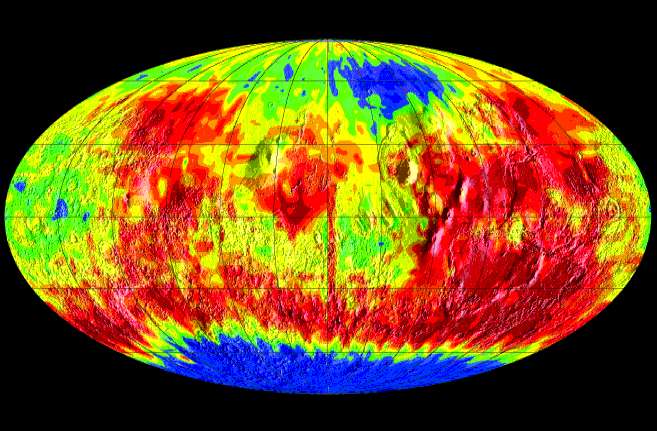Explanation: Looking for water on Mars, researchers using detectors on board the orbiting Mars Odyssey spacecraft have created this false-color global map of energetic neutrons from the otherwise Red Planet. What do neutrons have to do with water? As cosmic rays from interplanetary space penetrate the thin martian atmosphere and reach the surface they interact with elements in the upper layer of soil, scattering neutrons back into space. But if the martian soil contains hydrogen, it seriously absorbs energetic scattered neutrons. Tracking variations in absorption, neutron detectors can map changes in surface hydrogen content from orbit. Hydrogen content is taken as a surrogate measure of frozen water (H20), the most likely form of hydrogen close to the martian surface. Blue shades in the above map correspond to large concentrations of hydrogen, indicating in particular that the martian south polar region has a high amount of water ice near the surface.
1999 2000 2001 2002 2003 2004 2005 2006 2007 2008 2009 2010 2011 2012 2013 2014 2015 2016 2017 2018 2019 2020 2021 2022 2023 2024 2025 |
Yanvar' Fevral' Mart Aprel' Mai Iyun' Iyul' Avgust Sentyabr' Oktyabr' Noyabr' Dekabr' |
NASA Web Site Statements, Warnings, and Disclaimers
NASA Official: Jay Norris. Specific rights apply.
A service of: LHEA at NASA / GSFC
& Michigan Tech. U.
|
Publikacii s klyuchevymi slovami:
cosmic rays - neutron - hydrogen - Mars - Mars Odyssey - water - Mars - Mars Odissei 2001 - kosmicheskie luchi - neitron - vodorod - voda na Marse
Publikacii so slovami: cosmic rays - neutron - hydrogen - Mars - Mars Odyssey - water - Mars - Mars Odissei 2001 - kosmicheskie luchi - neitron - vodorod - voda na Marse | |
Sm. takzhe:
Vse publikacii na tu zhe temu >> | |
